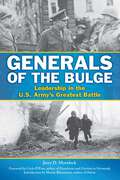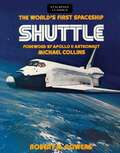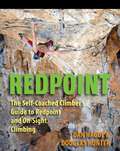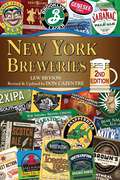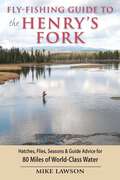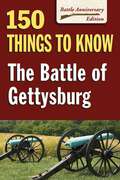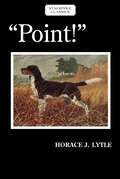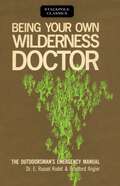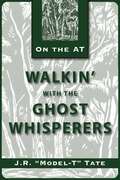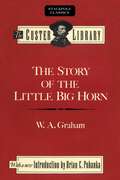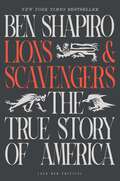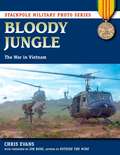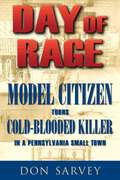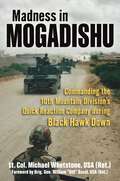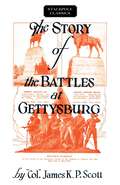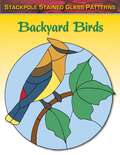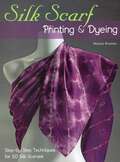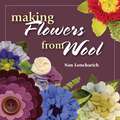- Table View
- List View
Founding Flies
by Mike Valla43 American fly-tying masters, including Mary Orvis Marbury, Thaddeus Norris, and Theodore Gordon.
Generals of the Bulge: Leadership in the U.S. Army's Greatest Battle
by Jerry D. MorelockThe Battle of the Bulge lives in history as the U.S. Army's largest and bloodiest battle of World War II. This innovative study of American military leadership in action during the battle examines the performance of six generals in the days and weeks after the German attack in December 1944.
Big Book of Texas Ghost Stories (Big Book of Ghost Stories)
by Alan BrownThe best ghost stories from the Lone Star State, including . . .• Spirits of the Alamo• The Black Hope Horror• Hauntings at the Driskill Hotel• The legend of El Muerto• Woman Hollering Creek• Stampede Mesa
World's First Spaceship Shuttle (Stackpole Classics)
by Robert M. PowersJoin the crew of space shuttle Enterprise as they prepare to take the first step into the twenty-first century. Step aboard the world&’s first reusable space vehicle with science writer Robert M. Powers for a cockpit view of a launch, orbit, re-entry, and return to earth. Preview the scheduled NASA shuttle missions in hundreds of line drawings and photographs of the crew at work in orbit. The shuttle system is the key to unlocking the next era of technology and the forerunner of space transportation systems of tomorrow: The world&’s first spaceship, the Enterprise, is here!
Redpoint
by Douglas Hunter Dan HagueThe first in-depth book on redpointing, where the climber does not weight the rope or pull or stand on manmade equipment.
New York Breweries (Breweries Series)
by Lew Bryson Don CazentreRevised and updated, this second edition features information on 89 breweries and brewpubs across the Empire State.
Fly-Fishing Guide to the Henry's Fork
by Mike LawsonIdaho's Henry's Fork was voted the best trout stream in America by Trout Unlimited members.
Battle of Gettysburg
by Sandy Allison• Concise introduction to the Gettysburg campaign• Facts about all aspects of the battle and its participants• Revised and expanded for the 150th anniversary of the battleJust some of the fascinating topics covered:• What led to the battle and why it was fought at Gettysburg• Who led the troops on both sides of the field• What average soldiers experienced, in their own words• Heroic actions and calamitous mistakes in judgment• What weapons were used and how effective they were• What happened to local civilians during and after the fight
Point! (Stackpole Classics)
by Horace J. LytleIn &“Point!&” the author has produced something considerably more than merely another book on the hunting of upland feathered game, and the canines that so gloriously help to make rays afield all that they can be. It even classifies, we believe, as a great human document—a book that will be valued all the more for tis contrast to present world chaos. It is basic in the fundamentals of our American heritage. It should help us all in a calm confident facing of what we do face today.Horace Lytle has lived 70 years, and in his book he covers most of them. Starting with the first point he ever saw, and the first quail he ever killed, he fascinatingly carries you with him from Mississippi to Saskatchewan, from Ohio to Florida—for Bob White, Grouse, Wood Prairie Chickens, with Ducks and Geese thrown in for good measure.Perhaps America&’s foremost pointing dog authority, he served for 20 years as Gun Dog Editor of Field and Stream. In &“Point!&” he pulls no punches on himself, but tells frankly of his own problems—even failures—with dogs of his own, some of which are screamingly funny as he tells them.Yes, this book is as amusing as it is importantly factual. You&’ll love it—from the very first page to the last. We have no doubt as to that. You&’ll learn many angles of how to hunt—how to shoot—and how to enjoy it all the more. A distinctly American book; none published has ever been more so.
Embroidered Christmas
by Cheryl FallGorgeous embroidery brightens up any Christmas scene! Decorate your home with original needlework designs--colorful stockings, embroidered tree centerpieces, and playful ornaments are sure to please. Wine presented in a hand-stitched bag makes a thoughtful gift, and felt peppermint candies draw the eye with holiday flair.
Being Your Own Wilderness Doctor (Stackpole Classics)
by Bradford Angier E. Russel KodetBeing your own wilderness doctor for the security of knowing what to do for the best—in case of the worst—a more than first-aid companion that&’s always there when a doctor may be too far away.Angier who knows the outdoors, and Dr. Kodet who knows people—inside and out—team up to present life-saving, panic-preventing information for times when making the right decision is most vital.Here are trip-saving ways to handle the sometimes painful but rarely serious accident-health problems that can face campers, hikers, and vacationers…cuts, sprains, insect bites, blisters burns. Here&’s what to do when a misstep results in fracture, break, dislocation, swelling. Know how a doctor would view symptoms that loom larger as the metropolis recedes; how he&’s handle the problem; how to differentiate between minor protests of hard used muscles and signs of serious trouble that call for prompt professional help.
How to Finance Any Real Estate, Any Place, Any Time
by James A. MiskoEver wonder how real estate magnates become real estate magnates? Not by filling out mind-numbing mortgage applications! For years, successful real estate investors have used creative money strategies that circumvent banks, yet result in profitable deals. Real estate professional James Misko makes these innovative techniques available to the general public in How to Finance Any Real Estate, Any Place, Any Time.This easy-to-use guide offers more than forty-five nontraditional ways to buy properties. You will learn how to turn your dwindling stocks into real estate equities, how to acquire land without money, and so much more. If the only thing holding you back from buying your dream house or investment property is financing, maybe it&’s time to buy &“outside the box&” with How to Finance Any Real Estate, Any Place, Any Time.
Walkin' with the Ghost Whisperers
by J. R. TateThree-time thru-hiker J. R. Tate explores the traditions and lore of the Appalachian Trail.
Colorado Breweries (Breweries Series)
by Dan RabinThis comprehensive guide covers all aspects of beer and brewing in Colorado.
Story of the Little Big Horn (Stackpole Classics)
by W. A. Graham&“Custer had been usually effective as an Indian fighter for several years… He was adept in bringing off surprise attacks that crushed and paralyzed resistance. Both his reputation and his experience as an Indian campaigner were second to none; and the Seventh Cavalry…was held one of the best regiments in the service. It was but natural, then, that when the regiment marched proudly away from the mouth of the Rosebud on its mission, Terry could and did feel confident that if he could but catch the recalcitrant braves of Sitting Bull between Custer and Gibbon, he would certainly crush and capture them; and if, perchance, Custer found them elsewhere than was expected, the Seventh Cavalry, under such a leader, would be more than equal to any emergency.&” From the Story of the Little Big HornIn June 1876, General George A Custer was detailed to a column under General Alfred H. Terry. After being sent ahead of General George Crook at the Rosebud River, Custer and the Seventh Cavalry discovered a Souix encampment on June 25. Not realizing that he was far outnumbered, Custer divided his regiment into three sections, sending two, led by Major Marcus A. Reno and Captain Frederick W. Benteen, to attack upstream. Custer&’s section stayed to launch a frontal assault, and every man under Custer was killed.Soon after the massacre, Custer became a tragic hero in the eyes of the American public, and the event achieved an almost mythological reputation. It was not until fifty years later, however, that the first book-length history of the battle, The Story of the Little Big Horn, was published.
Lions and Scavengers: The True Story of America (and Her Critics)
by Ben ShapiroINSTANT NEW YORK TIMES BESTSELLER #1 New York Times bestselling author Ben Shapiro examines the current state of America and Western civilization, and poses a question: will we be Lions, or will we be Scavengers? In a world split between noble Lions and destructive Scavengers, only the brave can lead the way. Acclaimed writer and conservative thought leader Ben Shapiro knows that at the heart of today&’s conflicts—political, economic, and cultural—there&’s a dangerous lie: that all people are equal in ability, and that all inequality stems from oppression and exploitation.With his signature clarity and sharp insight, Shapiro refutes that lie, emphasizing that in a free country, inequality is rooted in differences of talent and work ethic—not oppression—and that the best solution to lack of success lies in duty and virtue. Lions, like America&’s founding fathers, strive for the highest good, building systems that promote freedom, prosperity, and equality of opportunity. Meanwhile, Scavengers degrade these ideals, spreading resentment and entitlement that threaten to dismantle the foundations of Western civilization.In Lions and Scavengers, Shapiro invites you to take up the mantle of the Lion and defend the principles that shape the freedom of a fair, powerful society. With the stakes higher than ever, this book is a gripping exploration of the ongoing war between those who cherish our nation and those who seek to undermine it. The triumph of the Lions is essential for America&’s continued success. It&’s a rallying cry for those who refuse to bow to the Scavengers&’ demands. It&’s time to fight back.
Bloody Jungle (Stackpole Military Photo Series)
by Chris Evans• Visual history of the Vietnam War• Hundreds of photos, many of them rare and never published before• Photos of soldiers, helicopters and ground vehicles, villages and terrain, base camps, and more• Perfect complement to the narrative accounts in the Stackpole Military History Series, such as Street Without Joy and Land With No Sun
Ohio Breweries (Breweries Series)
by Rick Armon• 49 breweries and brewpubs • Types of beer brewed at each site and the author's pick of the best beer to try • Information on tours, takeout, and food for each brewery • Features on Ohio's beer festivals, Winking Lizard's World Beer Tour, and the Ohio Craft Brewers Association
Madness in Mogadishu
by Michael Whetstone William C. DavidOn the afternoon of October 3, 1993, two Black Hawk helicopters were shot down over the Somali capital of Mogadishu, leaving a handful of U.S. Army Rangers and Delta Force operators at the mercy of several thousand approaching militants. Ordered to "go find the glow"--the burning wreckage--hard-charging Capt. Mike Whetstone, commander of a Quick Reaction Company in the 10th Mountain Division, led part of the convoy sent to rescue the survivors. This powerfully vivid story of modern war is the intense firsthand account of the mission to find the crash site and retrieve the downed soldiers.
Story of the Battles at Gettysburg (Stackpole Classics)
by James K. ScottThe Harrisburg Telegraph says: &“…an unique and authoritative book, The Story of the Battles at Gettysburg&” will arouse great interest among military men throughout the country.&”It is not generally known that the three-day battle of Gettysburg, one of the most important and significant engagements of the Civil War, is included in the course of training of student officers in practically all the European war colleges as an outstanding example of tactics and strategy. Once a year the students of the West Point Military Academy spend several days at Gettysburg in studying the battle problems during the first three days of July 1863.The outstanding features to the military, are the maps of the battlefield…these maps are drawn to scale with careful fidelity and the position of each regiment and branch of service is shown every hour of the day at different stages in the progress of the battles.
How to Survive Anywhere
by Christopher NyergesWhether you're in an urban, suburban, rural, or wilderness environment, this book has all the information you need to survive a disaster. This book contains practical tips for anyone, anywhere, in almost any survival situation.
Backyard Birds (Stained Glass Patterns)
by Sandy AllisonA great selection of 25 patterns for making beautiful stained glass panels of backyard birds.
Silk Scarf Printing & Dyeing
by Melanie BrummerTechniques, tips, and inspiration for coloring and printing on undyed or solid-color silk scarves.Information on how different dyes react with different kinds of silk, how to blend dyes to get unique colors and patterns, different dyeing and printing methods, and how to compose eye-catching designsStep-by-step instructions for 50 different silk scarf projects in a wide range of colorways, styles, and difficulty levelsSpecial focus is put on using found objects and everyday household items to create your own unique "recycled prints"
Making Flowers from Wool
by Nan LoncharichUse simple techniques--hand stitching, cutting, and gluing--to create hundreds of different flowers for pins, hatbands, party favors, gifts, decorations, and more.

